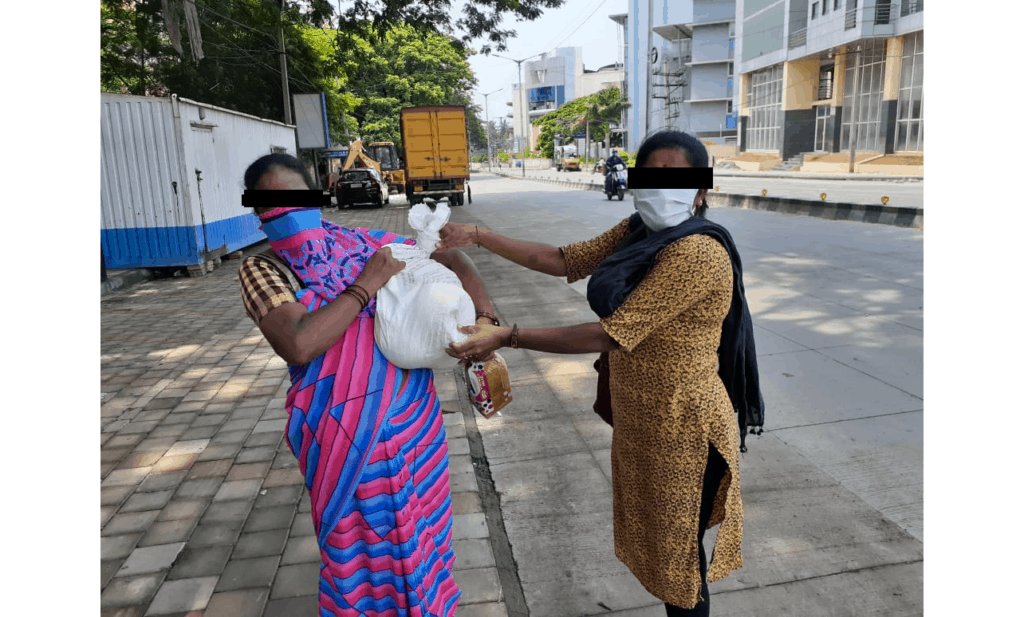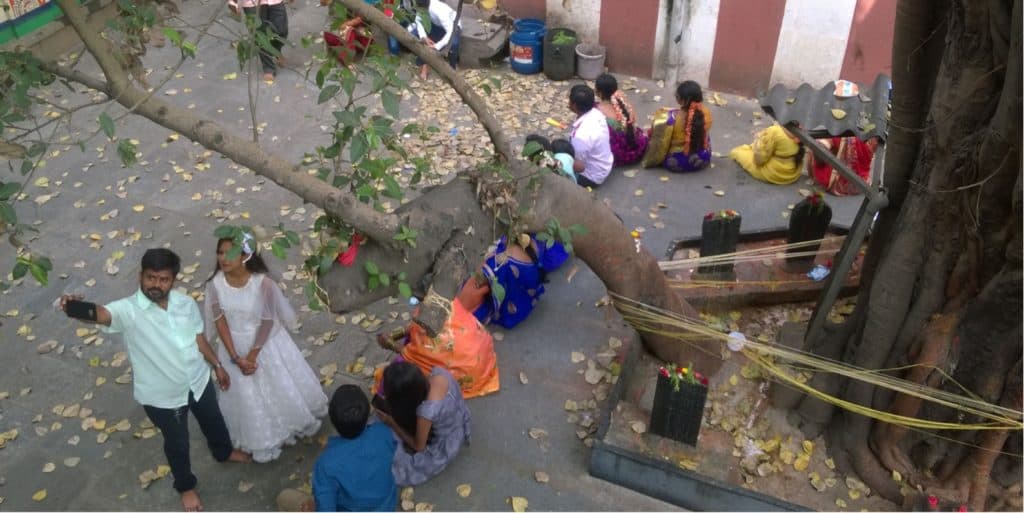How has Bengaluru city’s sweeping transformation over the last 30 years impacted its street-based sex workers? Bengaluru, which has no specific red light area, has hosted a vast landscape for street-based sex work – a category of informal labour that is not strictly illegal, but is considered undesirable and in urgent need of rescue and rehabilitation.
However, in the last three decades, the meaning of ‘public space’ has undergone a dramatic change in Bengaluru, alongside the definition of who ought to legitimately constitute the ‘public’ or ‘desirable worker’. Consequently, an entire ecology around street-based sex work has slowly disintegrated, pushing many of them into further invisibility and vulnerability.
Vast open grounds have vanished, as have large trees and their canopies, several buildings were demolished or replaced with fancy structures, metro lines and stations were built, public toilets disappeared, streets and pavements became more gentrified, parks began to be gated (sometimes ticketed) and cinema halls converted to malls and multiplexes, and so on.
As part of our research (due to be released as a book, but also published in the journals ‘City’, ‘Globalizations’ and ‘Gender, Technology, Development’), we spoke to more than 60 street-based sex workers in Majestic, KR Market, MG Road, Peenya, and Yeshwantpur for months, besides other institutions, individuals, and civil society organisations. They described how sex work used to be scattered across a range of public spaces in Bengaluru, supported by a diverse universe of people. And what it is like for them now.
Read more: How a collective helped Bengaluru’s sex workers get vaccinated

Lodge rooms, groves, parks, religious sites, bus stands, cinema theatres, thickets and large trees, pavements, public toilets, wholesale market yards, trucks, and shopping complexes were their work spaces. Their support network, with whom mutual investments in social capital helped sex workers coexist and survive the bodily and verbal assaults from the police, included lodge managers and staff, auto-rickshaw drivers, bus staff, street vendors, small shops, public toilet watchmen, park watchmen, cinema theatre staff, security guards, staff of restaurants and eateries, health workers, and social workers.
Lodges were their principal worksites, while street vendors provided them space to sit and rest. Auto-rickshaw drivers, hand-in-glove with lodge staff, ferried their customers and sometimes helped the workers escape the police, or sleep.
Cinema theatres were long a favourite of female workers, who worked at maintaining cordial relations with theatre staff. Parks – from Cubbon Park to local neighbourhood parks – were a haunt for transgender workers. Similarly, watchmen in construction sites or shopping complexes were also old accomplices.
Spaces around religious sites too, especially around Majestic and Gandhi Nagar, KR Market and Kalasipalayam, and surrounding areas, were important spots for sex workers. The shady peepul groves around these sites enabled not only solicitation but also recuperation. Some of them still exist, but are now cordoned off to prevent ‘immoral’ activities.
Large trees had a special place for solicitation, socialising , refuge from the police, and relaxation, and were spots to offer services after dusk. Even parthenium thickets in empty plots were worksites. Lakes permitted laundry and minor fishing during the mornings, and sex work for the rest of the day and night.
Public toilets were to male sex workers what lodges were for female workers. Most sex workers also spoke about how bus stands were, and to some extent still are, an important work spot.

No space for ‘undesirables’
However, the city transformed over time, and the everyday livelihood of sex workers became a trapeze act. They spoke of now having to find space behind giant sugarcane stacks, under mobile phone towers at night, small tracts behind garbage pileups, crevices in crumbling structures, isolated sections of bus stands, behind cobbler kiosks, and so on. And of how, alongwith the disappearance of parthenium infested tracts, lakes, groves and trees, their old accomplices began giving them the cold shoulder.
Sleepy watchmen turned into hostile security guards. Parks grew gates and barricades overnight (and being ticketed), with increased security. Lodges (and their staff) acquired a veneer of morality. Groves were transformed into manicured and gated parks. While ‘save the lake’ campaigns pushed for more recreational (or religious or artistic) purposes among the more affluent.
“Lodge managers began snubbing me…even the oldies who practically ran brothels in their lodges in the 1980s,” said one sex worker we spoke to. “I even heard that customers who asked about the availability of ‘services’ were told that ‘this wasn’t that kind of a place.’”
“When the lake was dying, no one came near it, and at least we could operate there. Even if it was dirty, our customers didn’t seem to mind. But they closed down my lake for about six months, put up a footpath around it, installed gates and then a security guard. The lake was saved. But my livelihood had gone.”
Public toilets also disappeared by the dozen, and the new ones built were manned and converted to pay and use kind. CCTV cameras were installed everywhere. But, the biggest loss for many female workers has been the steady decimation of single-screen cinema theatres and their replacement with shimmering malls and multi-screen theatres.
“I don’t know why they razed so many of them [toilets],” said another sex worker. “People are now urinating in the open, and we are facing difficulties in offering services. Even if we can afford to get into the new toilets paying the entry fee, they don’t want us in there.”
“You can do something in a bus stand, but the worst are the metro and all those flyovers that came up around them. They took a lot of land for that, which was our area too.”
Read more: Why Bengaluru sex workers couldn’t get ration kits during lockdown
Verbal and physical abuse against workers has been on the increase over the last few decades, not only on grounds of social morality and crime, but also that of ‘city image.’ Crusades against the prevention of the ‘misuse’ of ‘public’ spaces by ‘anti-social elements’ have enjoyed the full support of the middle and upper-middle classes, backed by the corporate sector, who wish to ‘rehabilitate’ the city’s image as being peaceful, air-conditioned, and content, engrossed with their own upmarket concerns around image, aesthetics, planning, administration, and environment.
The police are not the sex workers’ only adversaries now. There were new enemies among old ancillaries, and new threats within old places, and new predators such as native-language media scrutiny.
Sex workers now face invasive and humiliation tactics by aggressive reporting by television in particular, where they are portrayed as a thrilling scandal, complete with a narration of how shocking and exasperating it was to reflect on what has become of the city and how these women were destroying the sanctity of femininity. Opinions on the moral legitimacy of these workers, including questions on their very existence, are now thrown open to viewers.
“They rounded up many women once, some of them beggars and homeless, and surrounded them with cameras,” recalls a worker. “The man with the mic was not even asking us questions, but rattling away with his own descriptions, asking – ‘what is going on in our city?’ Later, when my friends told me they saw us on TV, I realized with shock that they were covering us live.”
For the street based sex worker, the way the city has changed is not just generating a sense of regret or nostalgia. But is today a serious matter on the hugely negative impact this is having on their everyday livelihood as well as magnifying their vulnerability. An entire layer of informal labour and livelihood is being wiped out, with only their longstanding benefactors (health workers, social workers, a few lawyers, journalists, and researchers) remaining sympathetic to them. In the sex workers’ eyes, only the city’s flora and fauna retain a supportive demeanour towards them.
Yet, street-based sex work still thrives in Bengaluru comprising thousands of workers, but as a pale shadow of what it was a few decades ago. Thousands of them have moved solicitation online and through mobile phones, with mixed experiences
“Their battles are now not only to protect their bodily rights but also to claim their inclusion in the city, its spaces, its workforce, and its people.” They have been vociferous in asserting that sex work is work, and sex workers are legitimate workers who are able to choose and provide for themselves through this occupation.
Also read:
- Sex workers demand decriminalisation of sex work, constituting welfare board
- The story of Bombay’s troubled history with its sex workers
- No income, no food, no government relief: Kamathipura’s sex workers pushed to the brink
- Why the NHRC recognition for sex workers makes us especially happy
- Taking healthcare to Delhi’s red light district
- COVID aftermath: Bengaluru sex workers suffer starvation, violence
I already commented related articles about sex workers in India or sexual slavery in India. Abusing them is not good at all because they are also humans. But it is better to educate them upto certain level and try to use human resources available. Prostituion in india or any other countries can not be stopped completely as even politicians are also into this. But regulation is needed for them and also education is needed for them. Some NGOs converted sexual workers into humanitarian or social workers or self employed oe some other jobs not selling values. Selling body is selling value but if it comes to national security in certain places, those places can not be avoided and if they girls or boys who are into this work with willingness and consents, it is better to regulate them. But try maximum to convert them to get educated and find a job